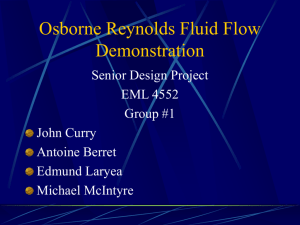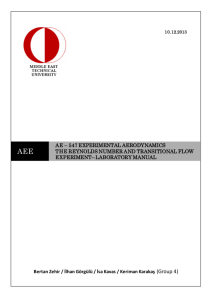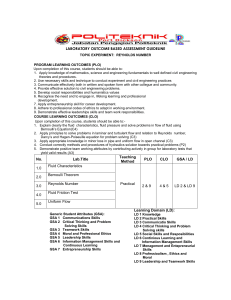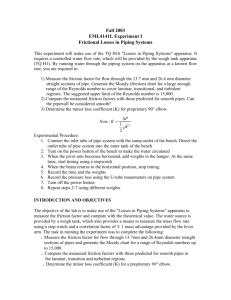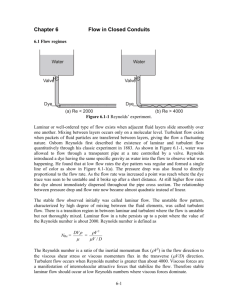Fluidized Bed Experiment
advertisement
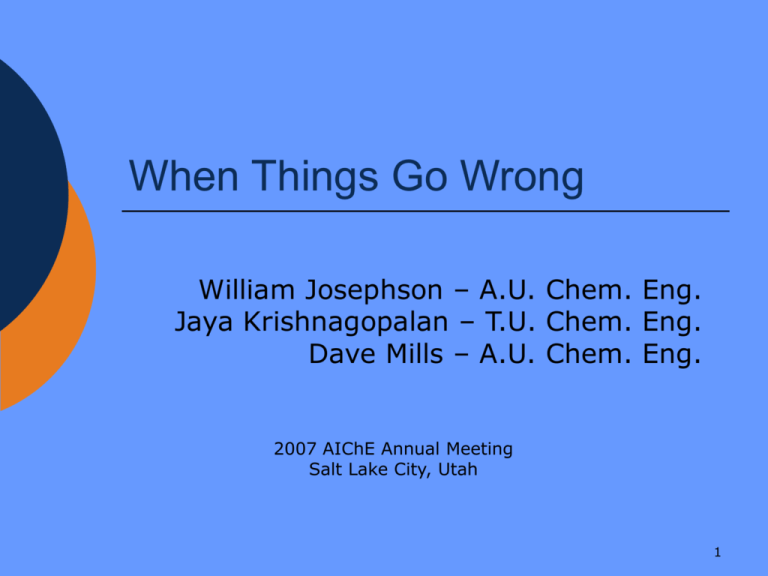
When Things Go Wrong William Josephson – A.U. Chem. Eng. Jaya Krishnagopalan – T.U. Chem. Eng. Dave Mills – A.U. Chem. Eng. 2007 AIChE Annual Meeting Salt Lake City, Utah 1 Outline & … 4 Experiments Conduction Reynolds Number Friction factor Viscosity For Each Experiment What should occur What did occur Why it happened What was learned 2 …Motivation 3 Conduction Heat Transfer Objectives To investigate Fourier’s Law for the linear conduction of heat along a simple brass bar To determine the average thermal conductivity of brass in the temperature range studied To observe the effect of temperature on the thermal conductivity of brass in the range studied 4 Conduction Heat Transfer Apparatus 5 Conduction Heat Transfer 6 Conduction Heat Transfer Conduction Experiment - Ideal Case 120 Temperature 100 80 60 40 20 0 0 10 20 30 40 50 60 70 80 Position 7 Conduction Heat Transfer Conduction Experiment - Thermocouple Error 120 Temperature 100 80 60 40 20 0 0 10 20 30 40 50 60 70 80 Position 8 Conduction Heat Transfer Conduction Experiment - Thermocouple Error plus T discrepancy across gaps 120 Temperature 100 80 60 40 20 0 0 10 20 30 40 50 60 70 80 Position 9 Conduction Heat Transfer Told students of problem Let them devise workaround Most students made use of knowledge of sample material – calculated 3 conductivities – eliminated bad thermocouple 10 Reynolds Number Objectives Compute Reynolds number Observe and quantify transitional flow 11 Reynolds Number Apparatus 12 Reynolds Number - “Ideal” Results Re Observations 500 Parallel streamlines – laminar flow 1000 Laminar 1500 Laminar 2000 Laminar 2500 Parallel & interacting streamlines – transient flow 3000 Interacting streamlines - turbulent flow 3500 Turbulent 4000 Turbulent 4500 Turbulent 5000 Turbulent 13 Reynolds Number The Problem Mixing of streamlines at Re = 700 Occurred for all groups 14 Reynolds Number Expected Reported Results Re Observations 500 Parallel streamlines – laminar flow 600 Laminar 650 Parallel & interacting streamlines – transient flow 700 Turbulent flow 800 Turbulent 1000 Turbulent 2000 Turbulent 3000 Turbulent 4000 Turbulent 5000 Turbulent 15 Reynolds Number Actual Reported Results Re Observations 500 Parallel streamlines – laminar flow 600 Laminar 650 Parallel & interacting streamlines – laminar flow 700 Interacting streamlines - laminar flow 800 Interacting streamlines - laminar flow 1000 Interacting streamlines - laminar flow 2000 Interacting streamlines - laminar flow 3000 Interacting streamlines - transient flow 4000 Interacting streamlines - turbulent flow 5000 Turbulent 16 Reynolds Number Cause of the Problem (physical) Nozzle at end of dye introduction pipe 17 Reynolds Number Cause of the Problem (“mental”) Poor wording in handout: “If the Reynolds number is less than 2100, the flow is considered laminar. If the Reynolds number is greater than 4000, the flow is considered turbulent.” 18 Piping Objectives To determine relationship between friction factor and Reynolds Number & roughness Friction losses in fittings (globe valve, elbows) Orifice meter 19 Piping Apparatus Direction of Flow Pipe A Pipe B Pipe C Pipe D Pipe E 20 Piping What we want them to do 21 Piping What we get (sometimes) Fanning Friction Factor versus Reynolds Number Fanning Friction Factor, f 0.1 1000 10000 100000 1000000 0.01 Pipe A Pipe B Pipe C Pipe D Pipe E 0.001 0.0001 Reynolds Number, NRe Important! – This is not the “problem” 22 Piping What we get (other times) Fanning Friction Factor 0.01 D - 29.0 E-04 E - 3.7 E-04 C - 2.9 E-04 B - 2.1 E-04 A - 1.6 E-04 0.001 10000 100000 Re Important! – This is the “problem” 23 Piping The Problem – friction factors for SS Pipe below those of PVC Consideration of the Problem Recheck the numbers A Lie in the handout?? (e.g., wrong info re pipe size) Deeper Thoughts – is this an issue w/ the SS pipe or the PVC pipes? Or both? 24 Viscosity Objectives To investigate rheology of several liquids Confirm Newtonian fluids Determine if shear-thickening, shear-thinning or something else Temperature effect on a Newtonian fluid 25 Viscosity 26 Viscosity Apparatus 27 Viscosity – Ketchup Results 250000 Viscosity (cP) 200000 150000 100000 50000 0 0 10 20 30 40 50 60 70 -50000 Shear Rate (RPM) 28 Viscosity – Corn Starch Results Cornstarch 2000 1800 Viscosity (cP) 1600 1400 1200 1000 800 600 400 200 0 0 0.5 1 1.5 2 2.5 3 3.5 Speed (RPM) 29 Corn Starch Viscosity The Problem – data indicates shear thinning Consideration of the Problem Recheck the numbers Try different concentrations Is corn starch really shear thickening? 30 Corn Starch Viscosity Is it really shear thickening?? 31 Corn Starch Viscosity Consideration of the Problem (cont.) Observe operation of viscometer esp. spindle interactions w/ fluid – closely read literature The Answer (& the solution) 32 Viscosity Corn Starch Results w/ Vane 200 195 190 Viscosity (cP) 185 180 175 170 165 160 155 150 0 10 20 30 40 50 60 RPM 33 What Went Wrong & What Happened Conductivity Bad Sensor, students were told a priori Students derived workaround Reynolds Number Physical Setup Students re-examined their thinking (as did the instructor!) Piping Arguably, nothing went wrong Students have to think Viscosity Improper equipment Students had to think & observe 34 A Sincere Thank You To the students in CENG 320 Unit Operations Laboratory I – T.U. & CHEN 3820 Chemical Engineering Laboratory I – A.U. 35

